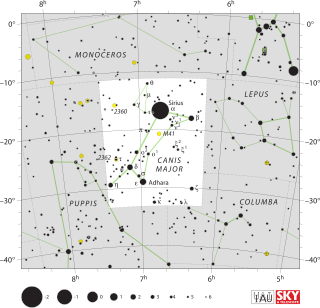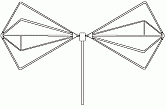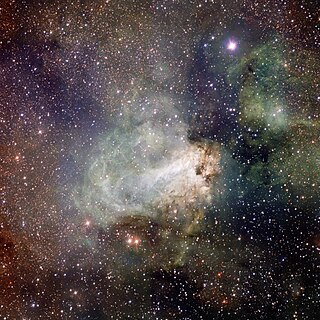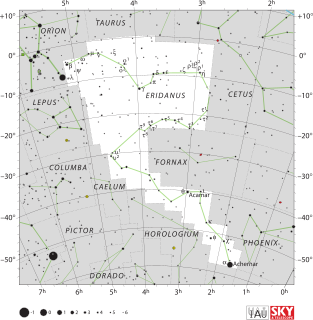
Canis Major is a constellation in the southern celestial hemisphere. In the second century, it was included in Ptolemy's 48 constellations, and is counted among the 88 modern constellations. Its name is Latin for "greater dog" in contrast to Canis Minor, the "lesser dog"; both figures are commonly represented as following the constellation of Orion the hunter through the sky. The Milky Way passes through Canis Major and several open clusters lie within its borders, most notably M41.

Corona Australis is a constellation in the Southern Celestial Hemisphere. Its Latin name means "southern crown", and it is the southern counterpart of Corona Borealis, the northern crown. It is one of the 48 constellations listed by the 2nd-century astronomer Ptolemy, and it remains one of the 88 modern constellations. The Ancient Greeks saw Corona Australis as a wreath rather than a crown and associated it with Sagittarius or Centaurus. Other cultures have likened the pattern to a turtle, ostrich nest, a tent, or even a hut belonging to a rock hyrax.

Lupus is a constellation of the mid-Southern Sky. Its name is Latin for wolf. Lupus was one of the 48 constellations listed by the 2nd-century astronomer Ptolemy, and it remains one of the 88 modern constellations but was long an asterism associated with the just westerly, larger constellation Centaurus.

In telecommunications and radar, a reflective array antenna is a class of directive antennas in which multiple driven elements are mounted in front of a flat surface designed to reflect the radio waves in a desired direction. They are a type of array antenna. They are often used in the VHF and UHF frequency bands. VHF examples are generally large and resemble a highway billboard, so they are sometimes called billboard antennas. Other names are bedspring array and bowtie array depending on the type of elements making up the antenna. The curtain array is a larger version used by shortwave radio broadcasting stations.

Andromeda is one of the 48 constellations listed by the 2nd-century Greco-Roman astronomer Ptolemy, and one of the 88 modern constellations. Located north of the celestial equator, it is named for Andromeda, daughter of Cassiopeia, in the Greek myth, who was chained to a rock to be eaten by the sea monster Cetus. Andromeda is most prominent during autumn evenings in the Northern Hemisphere, along with several other constellations named for characters in the Perseus myth. Because of its northern declination, Andromeda is visible only north of 40° south latitude; for observers farther south, it lies below the horizon. It is one of the largest constellations, with an area of 722 square degrees. This is over 1,400 times the size of the full moon, 55% of the size of the largest constellation, Hydra, and over 10 times the size of the smallest constellation, Crux.

Orion is a prominent constellation located on the celestial equator and visible throughout the world. It is one of the most conspicuous and recognizable constellations in the night sky. It is named after Orion, a hunter in Greek mythology. Its brightest stars are blue-white Rigel and red Betelgeuse.

The Boomerang Nebula is a protoplanetary nebula located 5,000 light-years away from Earth in the constellation Centaurus. It is also known as the Bow Tie Nebula and catalogued as LEDA 3074547. The nebula's temperature is measured at 1 K making it the coolest natural place currently known in the Universe.

Musca is a small constellation in the deep southern sky. It was one of 12 constellations created by Petrus Plancius from the observations of Pieter Dirkszoon Keyser and Frederick de Houtman, and it first appeared on a celestial globe 35 cm (14 in) in diameter published in 1597 in Amsterdam by Plancius and Jodocus Hondius. The first depiction of this constellation in a celestial atlas was in Johann Bayer's Uranometria of 1603. It was also known as Apis for 200 years. Musca remains below the horizon for most Northern Hemisphere observers.

In radio systems, a biconical antenna is a broad-bandwidth antenna made of two roughly conical conductive objects, nearly touching at their points.

Cepheus is a constellation in the northern sky, named after Cepheus, a king of Aethiopia in Greek mythology.
In computer science, a composite data type or compound data type is any data type which can be constructed in a program using the programming language's primitive data types and other composite types. It is sometimes called a structure or aggregate data type, although the latter term may also refer to arrays, lists, etc. The act of constructing a composite type is known as composition. Composite data types are often contrasted with scalar variables.

Kij Johnson is an American writer of fantasy. She is a faculty member at the University of Kansas.

The Omega Nebula, also known as the Swan Nebula, Checkmark Nebula, Lobster Nebula, and the Horseshoe Nebula is an H II region in the constellation Sagittarius. It was discovered by Philippe Loys de Chéseaux in 1745. Charles Messier catalogued it in 1764. It is by some of the richest starfields of the Milky Way, figuring in the northern two-thirds of Sagittarius.

Eridanus is a constellation in the southern celestial hemisphere. It is represented as a river. One of the 48 constellations listed by the 2nd century astronomer Ptolemy, it remains one of the 88 modern constellations. It is the sixth largest of the modern constellations, and the one that extends farthest in the sky from north to south. The same name was later taken as a Latin name for the real Po River and also for the name of a minor river in Athens.
A crab is a water-dwelling creature, a decapod crustacean of the infraorder Brachyura. A related common meaning is crab meat.

NGC 7380 is a young open cluster of stars in the northern circumpolar constellation of Cepheus, discovered by Caroline Herschel in 1787. The surrounding emission nebulosity is known colloquially as the Wizard Nebula, which spans an angle of 25′. German-born astronomer William Herschel included his sister's discovery in his catalog, and labelled it H VIII.77. The nebula is known as S 142 in the 1959 Sharpless catalog (Sh2-142). It is extremely difficult to observe visually, usually requiring very dark skies and an O-III filter. The NGC 7380 complex is located at a distance of approximately 8.5 kilolight-years from the Sun, in the Perseus Arm of the Milky Way.
Rescue at Midnight Castle, also known as Escape from Midnight Castle, or Rescue from Midnight Castle, and released later as Firefly's Adventure, My Little Pony in Dreamland and My Little Pony: Rescue at Midnight Castle is a 1984 animated television special based on the Hasbro toy line, My Little Pony. It was released as a pilot of the proposed television series, and featured the voices of Sandy Duncan and Tony Randall. A second special was produced in 1985, Escape from Catrina.

My Little Pony: Friendship Is Magic is an animated television series produced by Hasbro as part of the My Little Pony toy franchise, which is tied in with the 2010 relaunch of dolls and play sets and original programming for the American children's cable channel Discovery Family. Lauren Faust was selected as the creative developer and executive producer for the show based on her previous animation experience with other animated shows such as Cartoon Network's The Powerpuff Girls and Foster's Home for Imaginary Friends. Under Hasbro's guidance, Faust developed the show to appeal to the target demographic of young girls, but created characters and settings that challenged formerly stereotypical norms of "girly" images and added adventure and humorous elements in order to keep parents interested.

My Little Pony: Equestria Girls, or simply known as Equestria Girls, is a product line of fashion dolls and media franchise launched in 2013 by American toy company Hasbro, as a spin-off of the 2010 relaunch of the My Little Pony franchise and its Friendship Is Magic television series. Equestria Girls features anthropomorphized versions of My Little Pony characters from that period. It includes various doll lines, media tie-ins and licensed merchandise.














